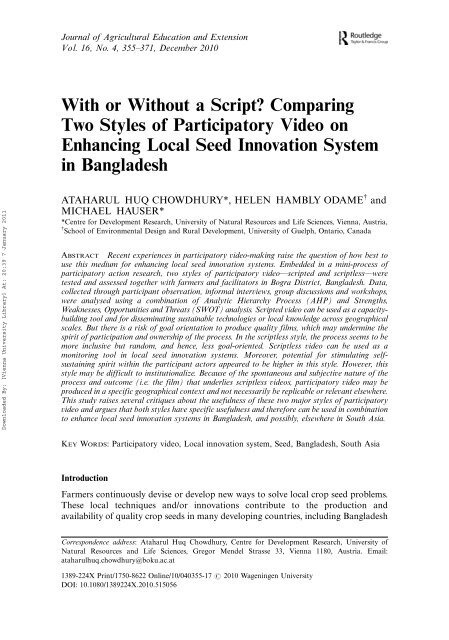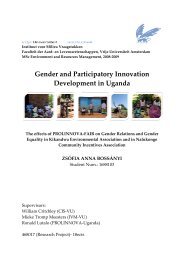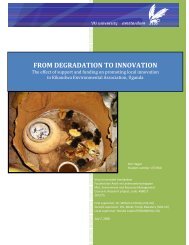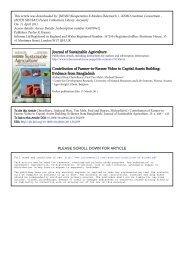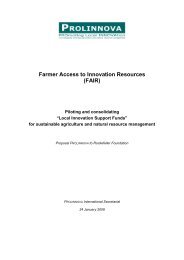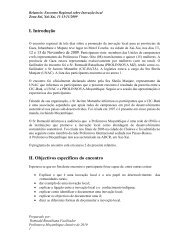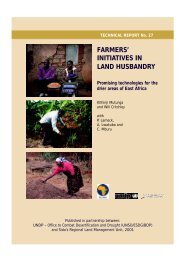Chowdhury et al (2010); PDF file - Prolinnova
Chowdhury et al (2010); PDF file - Prolinnova
Chowdhury et al (2010); PDF file - Prolinnova
You also want an ePaper? Increase the reach of your titles
YUMPU automatically turns print PDFs into web optimized ePapers that Google loves.
Journ<strong>al</strong> of Agricultur<strong>al</strong> Education and Extension<br />
Vol. 16, No. 4, 355371, December <strong>2010</strong><br />
With or Without a Script? Comparing<br />
Two Styles of Participatory Video on<br />
Enhancing Loc<strong>al</strong> Seed Innovation System<br />
in Bangladesh<br />
Downloaded By: [Vienna University Library] At: 20:39 7 January 2011<br />
ATAHARUL HUQ CHOWDHURY*, HELEN HAMBLY ODAME $ and<br />
MICHAEL HAUSER*<br />
*Centre for Development Research, University of Natur<strong>al</strong> Resources and Life Sciences, Vienna, Austria,<br />
$ School of Environment<strong>al</strong> Design and Rur<strong>al</strong> Development, University of Guelph, Ontario, Canada<br />
ABSTRACT Recent experiences in participatory video-making raise the question of how best to<br />
use this medium for enhancing loc<strong>al</strong> seed innovation systems. Embedded in a mini-process of<br />
participatory action research, two styles of participatory video*scripted and scriptless*were<br />
tested and assessed tog<strong>et</strong>her with farmers and facilitators in Bogra District, Bangladesh. Data,<br />
collected through participant observation, inform<strong>al</strong> interviews, group discussions and workshops,<br />
were an<strong>al</strong>ysed using a combination of An<strong>al</strong>ytic Hierarchy Process (AHP) and Strengths,<br />
Weaknesses, Opportunities and Threats (SWOT) an<strong>al</strong>ysis. Scripted video can be used as a capacitybuilding<br />
tool and for disseminating sustainable technologies or loc<strong>al</strong> knowledge across geographic<strong>al</strong><br />
sc<strong>al</strong>es. But there is a risk of go<strong>al</strong> orientation to produce qu<strong>al</strong>ity films, which may undermine the<br />
spirit of participation and ownership of the process. In the scriptless style, the process seems to be<br />
more inclusive but random, and hence, less go<strong>al</strong>-oriented. Scriptless video can be used as a<br />
monitoring tool in loc<strong>al</strong> seed innovation systems. Moreover, potenti<strong>al</strong> for stimulating selfsustaining<br />
spirit within the participant actors appeared to be higher in this style. However, this<br />
style may be difficult to institution<strong>al</strong>ize. Because of the spontaneous and subjective nature of the<br />
process and outcome (i.e. the film) that underlies scriptless videos, participatory video may be<br />
produced in a specific geographic<strong>al</strong> context and not necessarily be replicable or relevant elsewhere.<br />
This study raises sever<strong>al</strong> critiques about the usefulness of these two major styles of participatory<br />
video and argues that both styles have specific usefulness and therefore can be used in combination<br />
to enhance loc<strong>al</strong> seed innovation systems in Bangladesh, and possibly, elsewhere in South Asia.<br />
KEY WORDS: Participatory video, Loc<strong>al</strong> innovation system, Seed, Bangladesh, South Asia<br />
Introduction<br />
Farmers continuously devise or develop new ways to solve loc<strong>al</strong> crop seed problems.<br />
These loc<strong>al</strong> techniques and/or innovations contribute to the production and<br />
availability of qu<strong>al</strong>ity crop seeds in many developing countries, including Bangladesh<br />
Correspondence address: Ataharul Huq <strong>Chowdhury</strong>, Centre for Development Research, University of<br />
Natur<strong>al</strong> Resources and Life Sciences, Gregor Mendel Strasse 33, Vienna 1180, Austria. Email:<br />
ataharulhuq.chowdhury@boku.ac.at<br />
1389-224X Print/1750-8622 Online/10/040355-17 # <strong>2010</strong> Wageningen University<br />
DOI: 10.1080/1389224X.<strong>2010</strong>.515056


